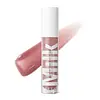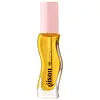What's inside
What's inside
 Key Ingredients
Key Ingredients

 Benefits
Benefits

 Concerns
Concerns

 Ingredients Side-by-side
Ingredients Side-by-side

Sucrose Acetate Isobutyrate
Simmondsia Chinensis Seed Oil
EmollientButyrospermum Parkii Butter
Skin ConditioningAgave Tequilana Leaf Extract
AstringentDipentaerythrityl Hexahydroxystearate/Hexastearate/Hexarosinate
Skin ConditioningJojoba Esters
EmollientIsononyl Isononanoate
EmollientTocopheryl Nicotinate
AntioxidantHelianthus Annuus Seed Wax
Skin ConditioningHelianthus Annuus Seed Oil
EmollientLycium Barbarum Fruit Extract
AstringentPersea Gratissima Oil
Skin ConditioningAcacia Decurrens Flower Wax
EmollientHibiscus Sabdariffa Flower Extract
Skin ConditioningRuby Powder
Skin ConditioningSapphire Powder
Tocopherol
AntioxidantTocopheryl Acetate
AntioxidantSilica Dimethyl Silylate
EmollientOctyldodecanol
EmollientCaprylic/Capric Triglyceride
MaskingPolyglycerin-3
HumectantVanillin
MaskingGlycerin
HumectantWater
Skin ConditioningSilica
AbrasiveMica
Cosmetic ColorantSodium Benzoate
MaskingPotassium Sorbate
PreservativeAroma
Citral
PerfumingLimonene
PerfumingLinalool
PerfumingCI 77891
Cosmetic ColorantIron Oxides
CI 73360
Cosmetic ColorantSucrose Acetate Isobutyrate, Simmondsia Chinensis Seed Oil, Butyrospermum Parkii Butter, Agave Tequilana Leaf Extract, Dipentaerythrityl Hexahydroxystearate/Hexastearate/Hexarosinate, Jojoba Esters, Isononyl Isononanoate, Tocopheryl Nicotinate, Helianthus Annuus Seed Wax, Helianthus Annuus Seed Oil, Lycium Barbarum Fruit Extract, Persea Gratissima Oil, Acacia Decurrens Flower Wax, Hibiscus Sabdariffa Flower Extract, Ruby Powder, Sapphire Powder, Tocopherol, Tocopheryl Acetate, Silica Dimethyl Silylate, Octyldodecanol, Caprylic/Capric Triglyceride, Polyglycerin-3, Vanillin, Glycerin, Water, Silica, Mica, Sodium Benzoate, Potassium Sorbate, Aroma, Citral, Limonene, Linalool, CI 77891, Iron Oxides, CI 73360
Polyglyceryl-2 Isostearate/Dimer Dilinoleate Copolymer
EmollientDilinoleic Acid/Propanediol Copolymer
EmollientVitis Vinifera Seed Oil
EmollientCarthamus Tinctorius Seed Oil
MaskingHelianthus Annuus Seed Oil
EmollientMauritia Flexuosa Fruit Oil
Skin ConditioningVaccinium Myrtillus Seed Oil
Skin ConditioningMel
EmollientOenothera Biennis Oil
EmollientRosa Canina Fruit Oil
EmollientTocopherol
AntioxidantEthylhexyl Palmitate
EmollientTrihydroxystearin
Skin ConditioningSodium Hyaluronate
HumectantGlucomannan
Skin ConditioningAroma
Calendula Officinalis Flower Extract
MaskingDaucus Carota Sativa Root Extract
Skin ConditioningCitrus Aurantium Bergamia Fruit Extract
Skin ConditioningPropolis Cera
AntiseborrhoeicCitronellol
PerfumingGeraniol
PerfumingLinalool
PerfumingLimonene
PerfumingCitral
PerfumingPolyglyceryl-2 Isostearate/Dimer Dilinoleate Copolymer, Dilinoleic Acid/Propanediol Copolymer, Vitis Vinifera Seed Oil, Carthamus Tinctorius Seed Oil, Helianthus Annuus Seed Oil, Mauritia Flexuosa Fruit Oil, Vaccinium Myrtillus Seed Oil, Mel, Oenothera Biennis Oil, Rosa Canina Fruit Oil, Tocopherol, Ethylhexyl Palmitate, Trihydroxystearin, Sodium Hyaluronate, Glucomannan, Aroma, Calendula Officinalis Flower Extract, Daucus Carota Sativa Root Extract, Citrus Aurantium Bergamia Fruit Extract, Propolis Cera, Citronellol, Geraniol, Linalool, Limonene, Citral
 Reviews
Reviews

Ingredients Explained
These ingredients are found in both products.
Ingredients higher up in an ingredient list are typically present in a larger amount.
Aroma refers to an ingredient, or mixture of ingredients, that impart or mask a flavor.
The name is slightly confusing. This is because INCI associates aroma with flavor instead of smell.
Here is the official definition from the The International Cosmetic Ingredient Dictionary and Handbook:
“Aroma is a term for ingredient labeling used to identify that a product contains a material or combination of materials normally added to a cosmetic to produce or to mask a particular flavor.”
INCI shows the only purpose of aroma to be "flavouring".
However, due to regulation differences, some companies may use aroma in place of parfum.
In Canada, this ingredient only has to be listed in concentrations above 1%.
Learn more about AromaCitral is a fragrance and used to add a lemon-like scent to products. It is both naturally found in plants and created synthetically. In plants, it is commonly occurring in lemon myrtle, lemongrass, lemon tea-tree, lemon verbena, and other citruses.
The EU mandates Citral be listed separately as a fragrance. It is a known allergen and may cause contact dermatitis. Citral can also used as a masking ingredient.
The term 'fragrance' is not regulated in many countries. In many cases, it is up to the brand to define this term. For instance, many brands choose to label themselves as "fragrance-free" because they are not using synthetic fragrances. However, their products may still contain ingredients such as essential oils that are considered a fragrance.
The term 'citral' is a collective term for two geometric isomers: geranial/Citral A and neral/Citral B.
Learn more about CitralHelianthus Annuus Seed Oil is the oil derived from the seeds of a Sunflower. Sunflower seed oil is non-fragrant. It is an emollient, meaning it helps to soften the skin.
Sunflower seed oil contains many fatty acids. The fatty acids found in sunflower seeds include (from highest amount to least): linoleic acid, myristic acid, palmitic acid, stearic acid, arachidic acid, oleic acid, and linolenic acid.
These fatty acids help the skin create ceramides. Ceramides play a role in repairing the skin barrier.
Helianthus Annuus Seed Oil helps moisturize the skin. This in turn helps the skin look more rejuvenated and smoother.
Sunflowers are rich in vitamin E.
Historians believe Indigenous cultures of North America domesticated sunflowers before corn. Thus they relied on sunflower oil for a variety of uses. One such use is moisturizing skin and hair.
Sunflower seed oil may not be fungal acne safe. We recommend speaking with a professional if you have any concerns.
Learn more about Helianthus Annuus Seed OilLimonene is a fragrance that adds scent and taste to a formulation.
It's found in the peel oil of citrus fruits and other plants such as lavender and eucalyptus. The scent of limonene is generally described as "sweet citrus".
Limonene acts as an antioxidant, meaning it helps neutralize free radicals.
When exposed to air, oxidized limonene may sensitize the skin. Because of this, limonene is often avoided by people with sensitive skin.
The term 'fragrance' is not regulated in many countries. In many cases, it is up to the brand to define this term. For instance, many brands choose to label themselves as "fragrance-free" because they are not using synthetic fragrances. However, their products may still contain ingredients such as essential oils that are considered a fragrance.
Learn more about LimoneneLinalool is a fragrance and helps add scent to products. It's derived from common plants such as cinnamon, mint, citrus, and lavender.
Like Limonene, this ingredient oxidizes when exposed to air. Oxidized linalool can cause allergies and skin sensitivity.
This ingredient has a scent that is floral, spicy tropical, and citrus-like.
Learn more about LinaloolTocopherol (also known as Vitamin E) is a common antioxidant used to help protect the skin from free-radicals and strengthen the skin barrier. It's also fat soluble - this means our skin is great at absorbing it.
Vitamin E also helps keep your natural skin lipids healthy. Your lipid skin barrier naturally consists of lipids, ceramides, and fatty acids. Vitamin E offers extra protection for your skin’s lipid barrier, keeping your skin healthy and nourished.
Another benefit is a bit of UV protection. Vitamin E helps reduce the damage caused by UVB rays. (It should not replace your sunscreen). Combining it with Vitamin C can decrease sunburned cells and hyperpigmentation after UV exposure.
You might have noticed Vitamin E + C often paired together. This is because it is great at stabilizing Vitamin C. Using the two together helps increase the effectiveness of both ingredients.
There are often claims that Vitamin E can reduce/prevent scarring, but these claims haven't been confirmed by scientific research.
Learn more about Tocopherol